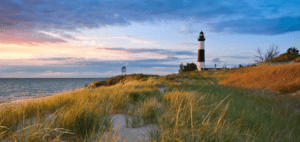Peaks Spirits: Unveiling the Myths of Ireland Mountains
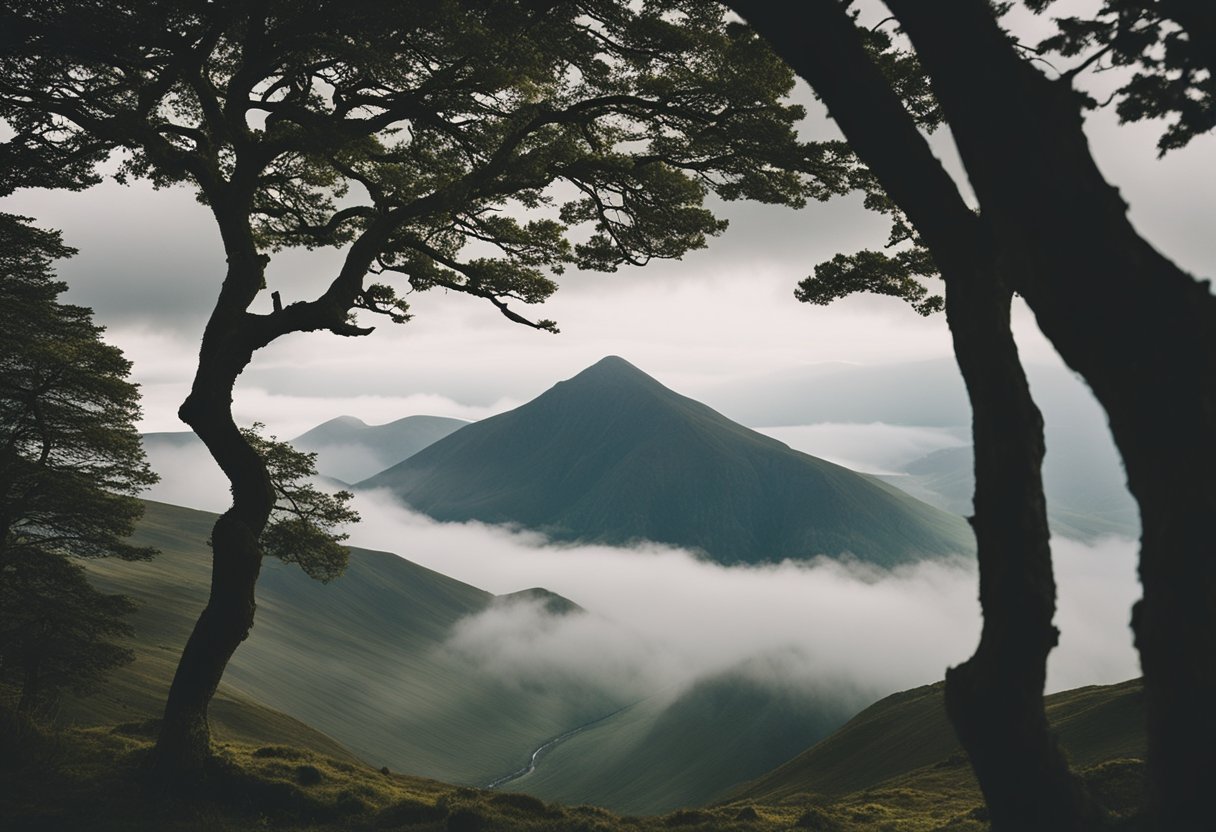
Updated On: April 22, 2024 by Eman Sameh
Ireland mountains are steeped in mystery and adorned with legends that have been passed down through generations. From the ancient tales etched into the rugged outlines of the Wicklow Mountains to the mystical traditions that enshroud the MacGillycuddy’s Reeks, our Emerald Isle’s peaks serve as silent guardians of our nation’s history and culture. As we traverse the rolling hills and towering heights, it’s impossible not to feel the presence of something larger than life—a sense of connection to the spirits that folklore claims roam these heights.
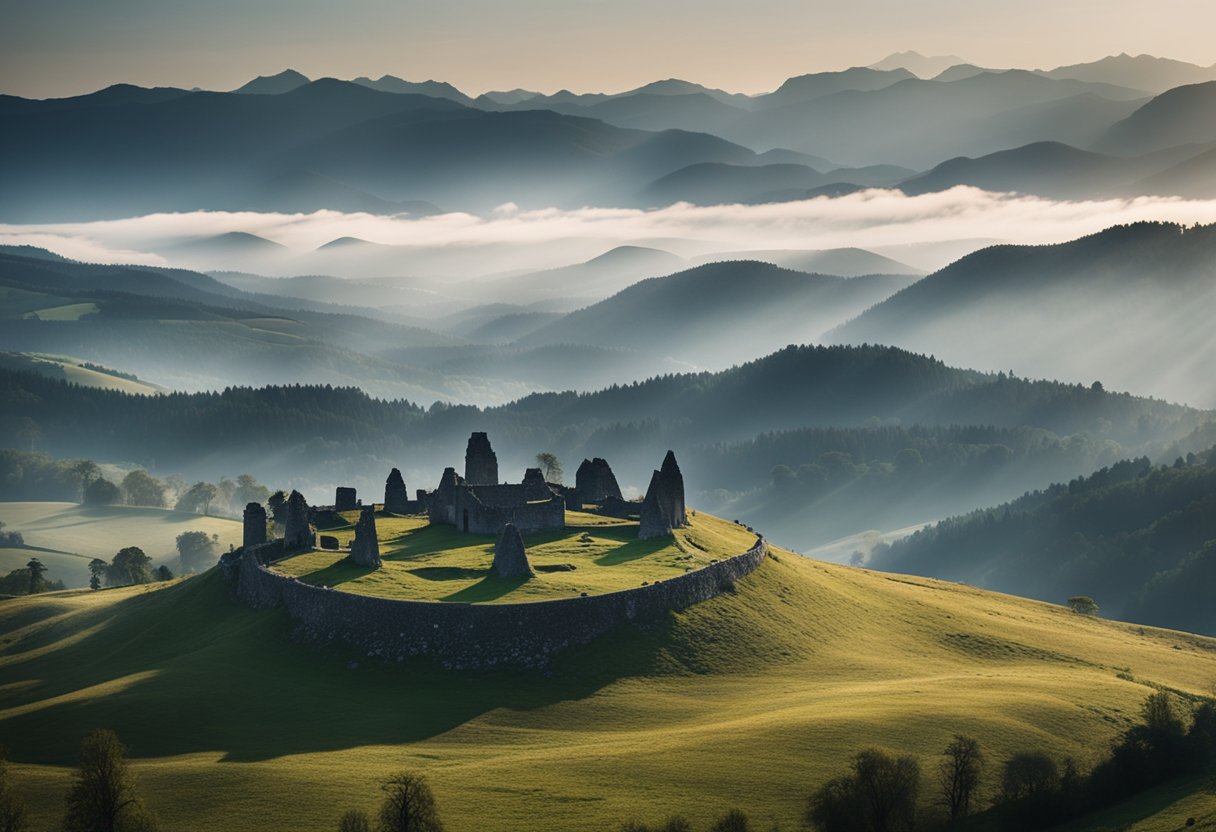
As custodians of these tales, we acknowledge not just the supernatural elements that lend an air of enchantment to our highlands but also the very real significance of these settings in the history and culture of Ireland. The mountains are an integral part of our natural environment, and their conservation is critical in preserving both the beauty and the biodiversity of our landscapes. In exploring the legends of Ireland’s peaks, we also delve into the practicalities of mountain access and safety, ensuring that we honour these spaces by treading lightly and responsibly.
Ireland Mountains
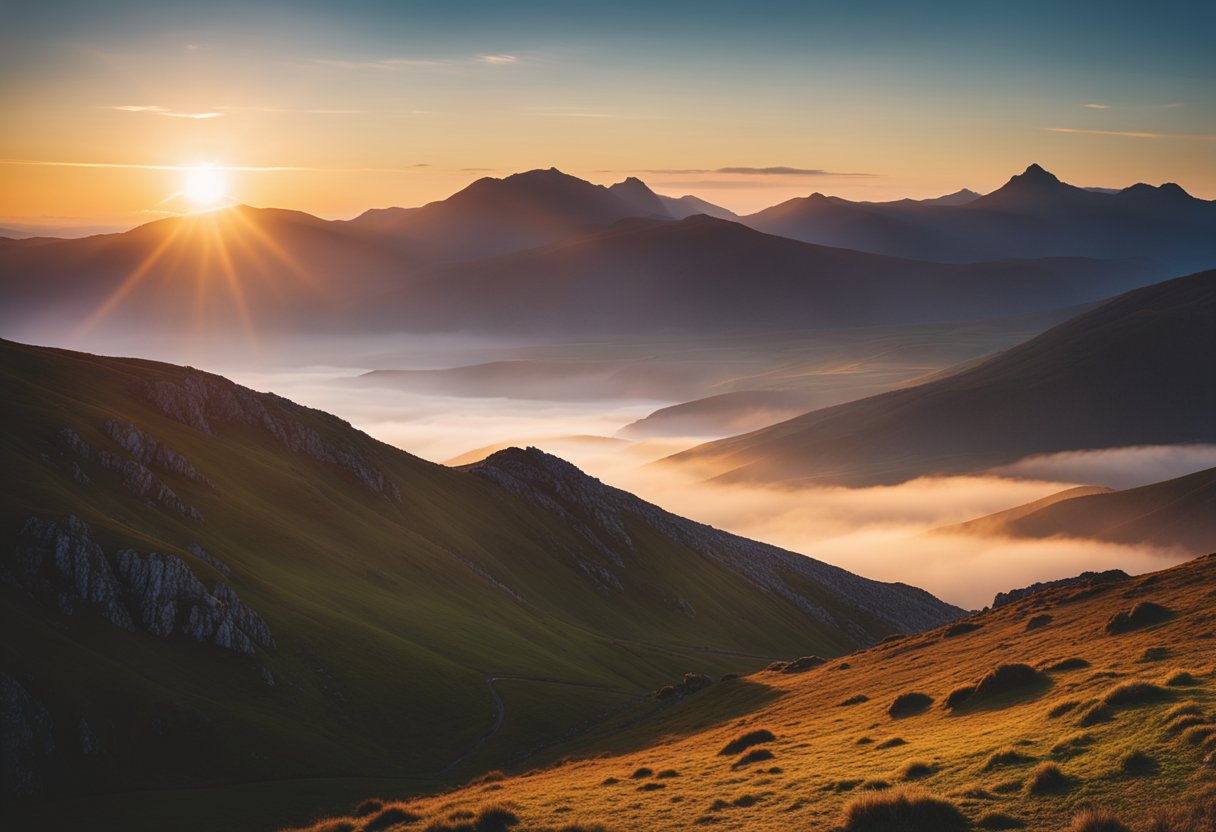
Ireland boasts a landscape rich with majestic mountains that serve as a testament to the nation’s natural beauty. Our highest peaks are concentrated primarily in County Kerry, providing not just thrilling challenges for hillwalkers but also habitats for diverse mountain environments.
Carrauntoohil
Carrauntoohil is Ireland’s highest peak, reaching an impressive height of 1,038 metres. It’s part of MacGillycuddy’s Reeks in County Kerry, revered not just for its elevation but also for the breathtaking scenery it offers. Ordnance Survey Ireland recognises this mountain as a pinnacle, drawing hikers from across the globe, captivated by the rugged beauty and the legends intertwined with its ascent.
MacGillycuddy’s Reeks
The MacGillycuddy’s Reeks claim some of Ireland’s most formidable mountain ranges, including Carrauntoohil. These peaks boast a number of other notable summits exceeding 1,000 metres, forging part of the country’s most beloved highland terrains. The area echoes tales of ancient spirits and presents a landscape that encapsulates the essence of Ireland’s mountainous spirit.
Mountain Access and Safety

In the pursuit of summiting Ireland’s majestic peaks, we must prioritise access guidelines and safety protocols to ensure an enjoyable and secure experience for all.
Walking Routes
Our nation’s mountains boast a wide array of walking routes that cater to various levels of experience. Our guidebook, Irish Peaks, offers detailed route descriptions covering all of Ireland’s main mountain areas. It is essential to select a path that aligns with our ability and to check whether the specific route lies within a national park or on private land, as this can affect access rights.
- Safety: Always review weather conditions before embarking on a walk.
- Responsible Engagement: Respect the natural environment and local wildlife.
- Route Descriptions: Plan your journey with current maps and guides.
Climbing Guidelines
Climbing in Ireland must be approached with respect for the mountain environment and the inherent risks it presents. We adhere to established climbing guidelines that encompass both safety and responsible engagement with the mountain terrain.
- Access: Ensure you have the right to climb, particularly in areas outside of national parks.
- Safety: Use appropriate climbing gear and be aware of sudden weather changes.
By embracing these practices, we support safe and responsible adventures amongst Ireland’s legendary peaks.
Ireland’s Mountain Legends
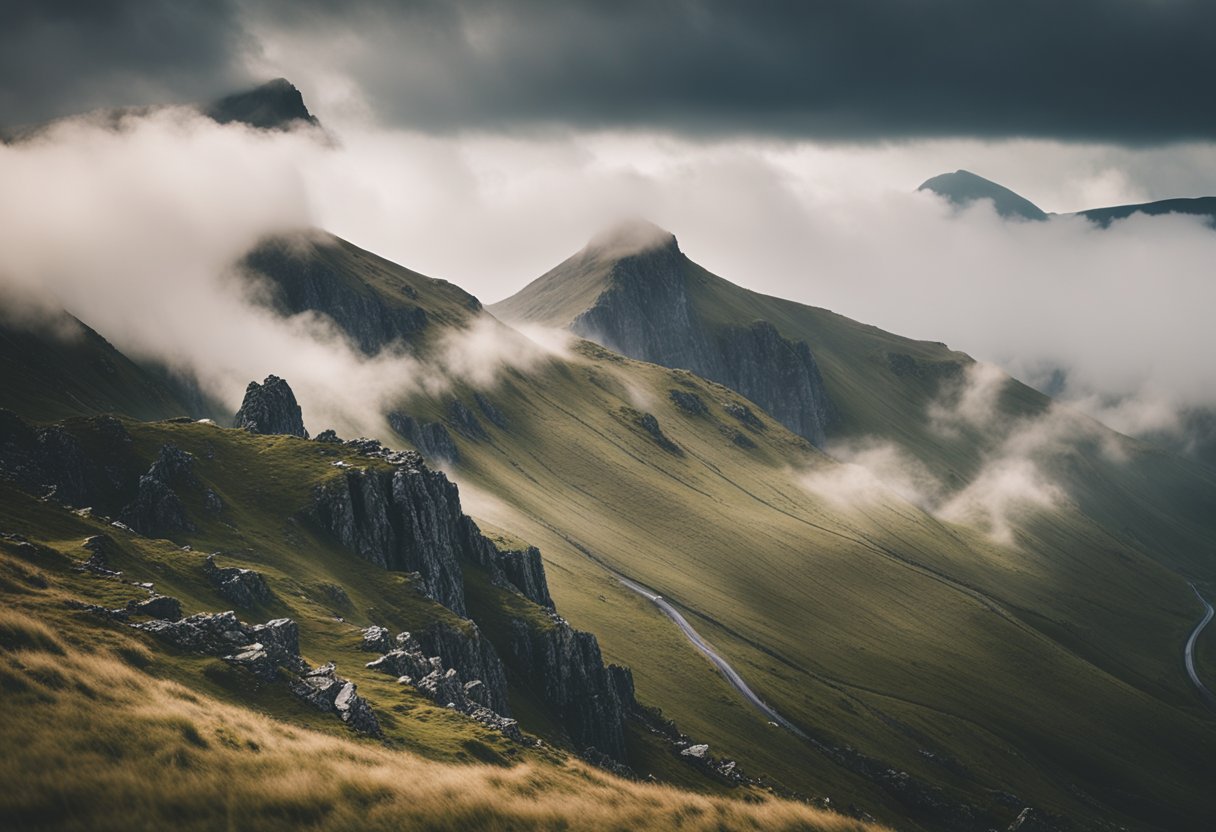
Ireland’s mountainous terrains are steeped in tales that weave together the fabric of Gaelic culture. Laden with legends, each peak has its own story, populated by deities and heroes of old.
The Myths of Carrauntoohil
Carrauntoohil, the highest peak in Ireland, is not just a geographical landmark but also a cornerstone of Irish mythology. This towering mountain is said to have been the throne of the ancient deity Crom Dubh. Legend tells us that Crom Dubh was a dark and malevolent force, defeated by Saint Patrick, Ireland’s patron saint. This tale represents the victory of Christianity over the old pagan deities. It’s not surprising that such a prominent feature of the Irish landscape would be home to epic legends featuring deities and heroes.
Sacred Sites and Pilgrimages
Ireland’s mountains have long been associated with sacred sites and pilgrimages, echoing the beliefs and ritual practices through the ages. Croagh Patrick, affectionately known as ‘The Reek’, is a prime example. It’s said that Saint Patrick fasted there for forty days and nights, which is commemorated on Reek Sunday when thousands make the pilgrimage up this holy mountain. The tradition merges Celtic spirituality with Christian pilgrimage, creating a unique practice that has lasted through centuries. Similarly, Slieve League and Mam Ean are imbued with spiritual significance, becoming pilgrimage destinations for those seeking solace and spiritual connection.
Historical and Cultural Significance
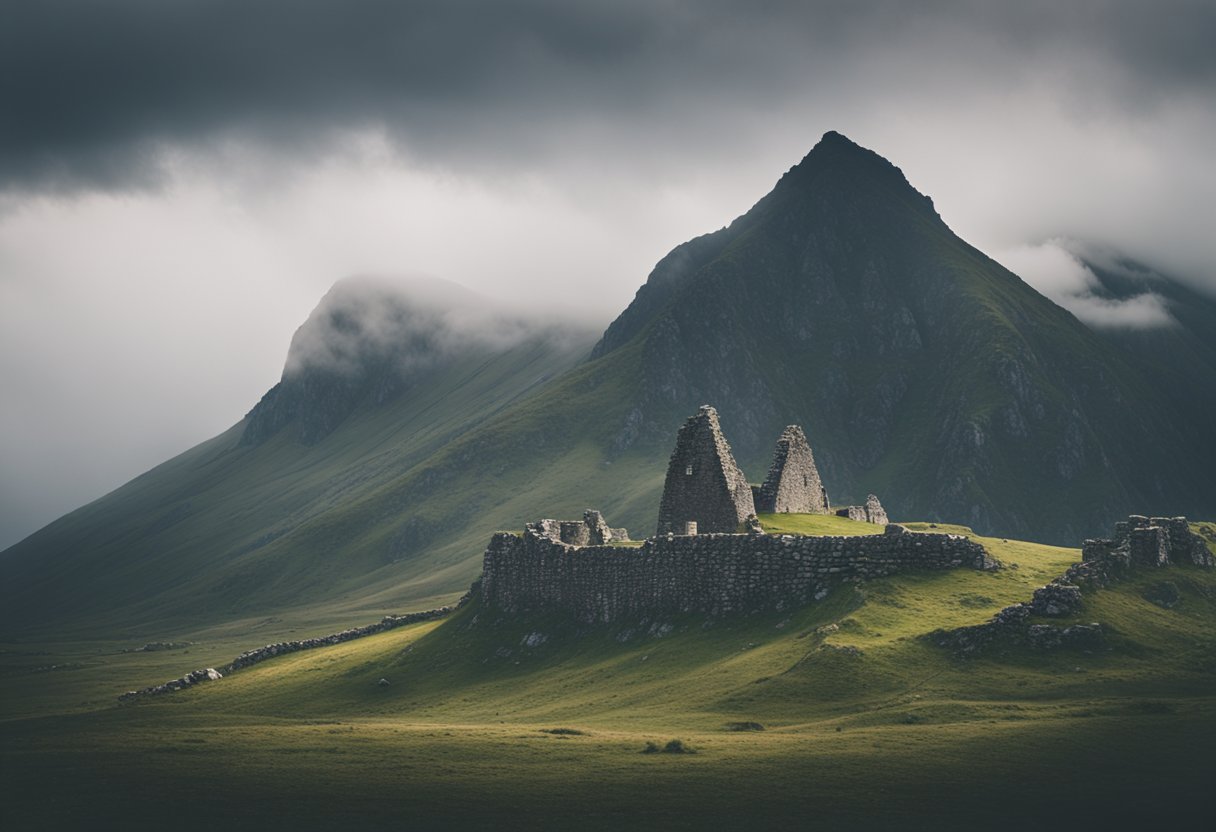
The mountains of Ireland stitch a rich tapestry through our history and culture, bearing witness to centuries of folklore, art, and spiritual practices. Their majestic beauty has shaped local communities, drawn pilgrims, and inspired countless hillwalkers.
Mountaineering Ireland
Mountaineering in Ireland is more than a sport; it’s woven into the cultural fabric of our nation. Irish peaks like Carrauntoohil and Lugnaquilla resonate not just with natural grandeur but also with stories and legends from the past. In climbing these peaks, hillwalkers tread paths laden with history—tracing the routes of ancient pilgrimages and offering a nod to the enduring strength of local communities that have thrived alongside these towering landscapes.
Every ascent is a journey through time, as these mountains hold a mirror to Ireland’s past—from the prehistoric era to the present day. They tell of a land where nature and spirituality are inextricably linked, inviting walkers to reflect on a chapter in Irish life when every rise in the land was suffused with significance, where each mountain was not just a summit but a sacred space.
The support of hillwalking clubs across the country fosters a love for the Irish outdoors. These clubs play a pivotal role in preserving the traditions of mountaineering in Ireland. They act as custodians of the hills, simultaneously celebrating their cultural heritage and protecting it for future generations. It’s these communities that keep the history of mountaineering in Ireland alive, ensuring that the legends embedded in our landscape will continue to inspire awe and wonder.
Natural Environment and Conservation

Ireland’s mountain regions are rich tapestries of natural beauty, each woven with diverse flora and fauna. As stewards of these landscapes, we have a collective responsibility for their conservation, ensuring that the verdant textures and wildlife spectacles continue to thrive for generations to enjoy.
Flora and Fauna
In Ireland, mountain vistas offer more than scenic beauty; they are home to an array of unique plant and animal life. Heathers and gorse decorate the slopes with vivid colours, while peatlands and blanket bogs nestle among the valleys—critical habitats for insect and bird species. Rare orchids flourish alongside rushing streams, and the calls of skylarks fill the air.
The protection of these ecosystems is paramount. Through conservation efforts, we endeavour to maintain the integrity of the natural environment, safeguard biodiversity, and promote mountain views that are as ecologically rich as they are visually spectacular. Conservation programmes focused on the preservation of native species and the restoration of natural habitats are ongoing, reinforcing the importance of these landscapes in our natural heritage.
Our engagement in the natural environment includes not just enjoyment but also an active role in its sustainability. By understanding and respecting the delicate balance of these ecosystems, we contribute to their longevity. Remembering that every step taken on a mountain trail leaves an imprint, we advocate for and practice responsible exploration that minimises environmental impact.
Mountain Ranges and Key Locations
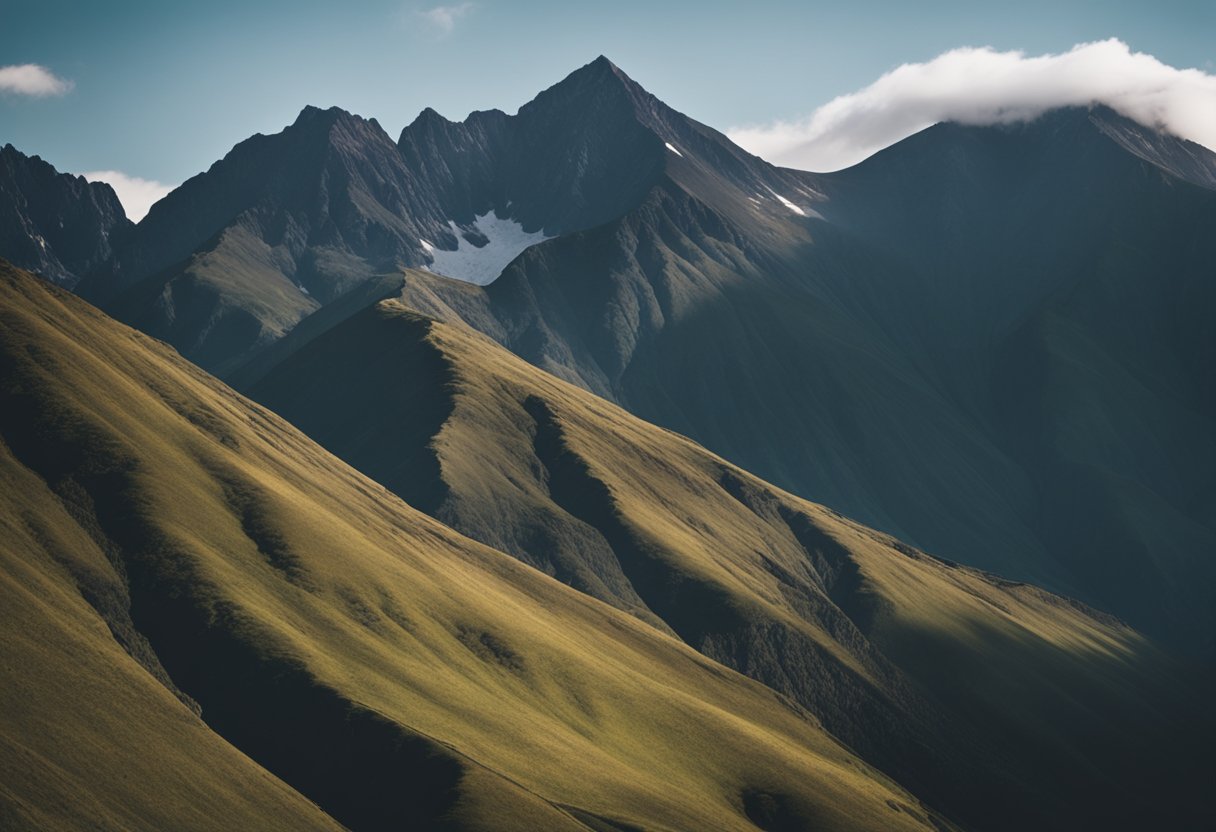
In Ireland’s rugged landscape, mountain ranges are the backdrop to legendary tales and cultural heritage. We’ll explore key locations where nature’s grandeur and myth intertwine.
Iveragh Peninsula
Situated in County Kerry, the Iveragh Peninsula is renowned for its dramatic landscapes. The Na Cruacha Dubha range, also known as the Black Stacks, cuts a mighty silhouette against the skyline. Here, the Beenkeragh Ridge offers a formidable challenge to hikers, connecting the two highest peaks in Ireland—Carrauntoohil and Beenkeragh.
The Dingle Peninsula
Just to the north, the Dingle Peninsula harbours a quieter mystique. It’s home to a wealth of archaeological sites set amongst rolling hills and jagged peaks. The Connor Pass weaves through the landscape, granting travellers breathtaking views of the coastline and the patchwork fields beyond.
Mountaineering and Hiking Essentials
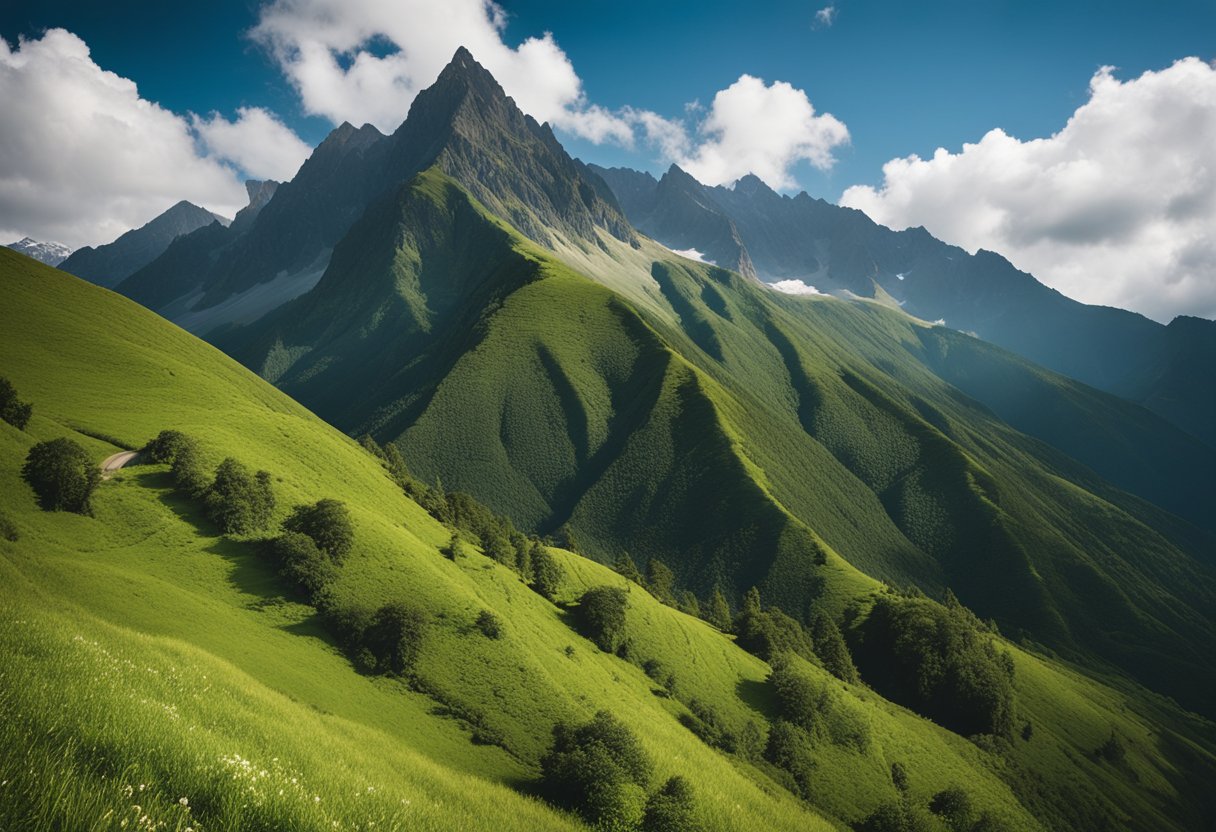
As seasoned mountaineers and avid hikers, we understand the importance of being well-equipped and knowledgeable when venturing into Ireland’s majestic mountains. Whether you’re scaling Carrauntoohil or exploring the undulating trails of the Wicklow Mountains, the right gear and navigation skills are paramount for a safe and enjoyable experience.
Equipment
Footwear: It is critical to ensure you have the right boots for the terrain. They should provide good ankle support and be waterproof to withstand Ireland’s often wet conditions.
Clothing: Investing in layered clothing ensures you can adapt to changing weather. Always carry a waterproof jacket and thermal layers.
Climbing gear: For climbers, selecting quality ropes, harnesses, and carabiners is non-negotiable. Each piece must meet rigorous safety standards.
Emergency Kit: A kit including a first aid pack, survival blanket, whistle, and torch is essential for any unexpected situations.
Respect for nature and landowners: When hiking or climbing, we must respect the natural environment and follow local regulations to maintain good relationships with landowners and preserve the integrity of trails.
Navigation
Maps: An Ordnance Survey Ireland (OSI) map is the most reliable source for navigating Ireland’s peaks. It’s essential to know how to read these topographic maps.
Compass: A compass is a crucial tool. Learn to use it in conjunction with your OSI map to navigate effectively in areas with low visibility or undefined trails.
GPS Devices: Modern technology like GPS devices can be an asset, but we should never rely on them solely. Batteries can fail, so always have a traditional map and compass as backup.
By rigorously preparing with the proper equipment and honing our navigation skills, we optimise our chances for an exhilarating and secure mountaineering or hiking experience amidst the legends of Ireland’s peaks.
Weather Patterns and Planning
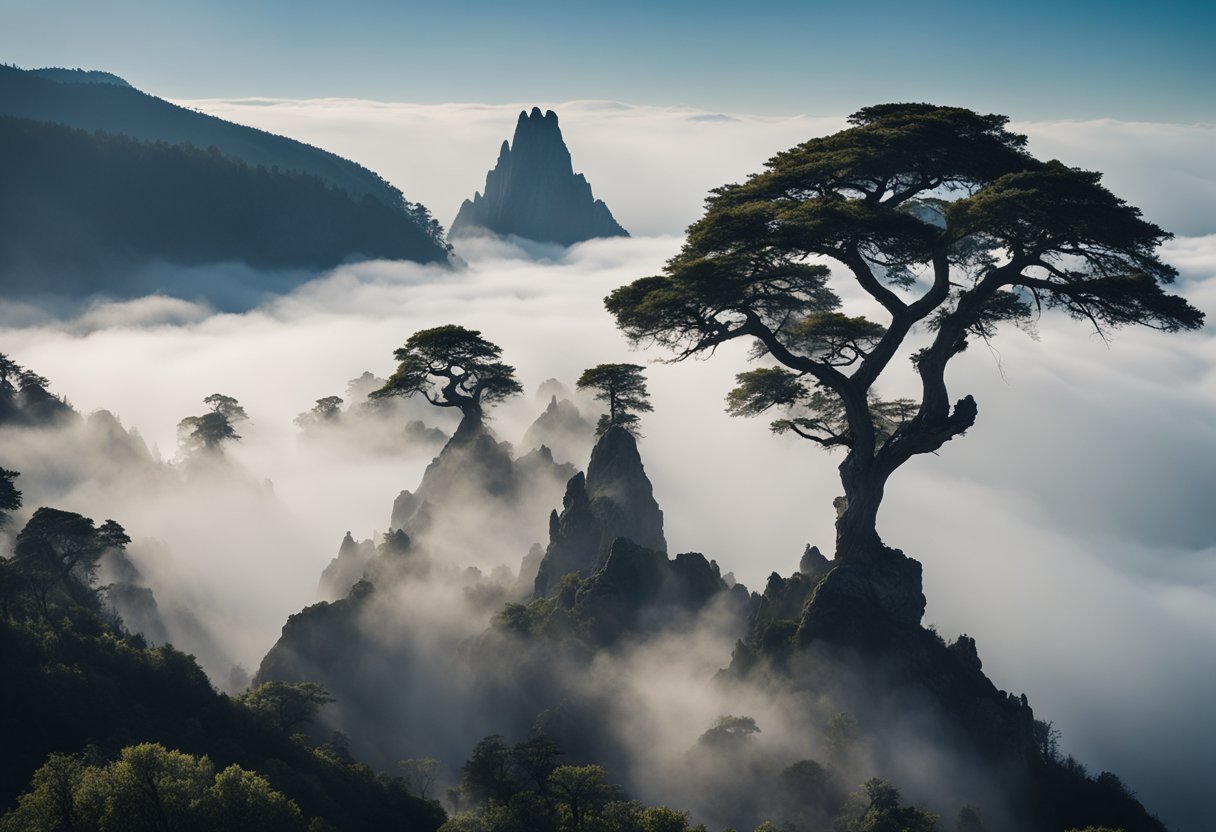
Understanding the local weather patterns is crucial for a safe and enjoyable journey into Ireland’s majestic peaks. Ireland’s climate is notoriously unpredictable, and mountain conditions can change rapidly.
Weather: In the highlands, weather can shift from clear skies to dense fog within minutes. Before setting out, we always check the latest weather forecasts and remain vigilant for sudden changes. It’s vital to prepare for rain, wind, and temperature variations that are common in the mountain environment.
Guidebook: Carrying a reliable guidebook with comprehensive route descriptions is essential. We ensure that our guidebook includes details on the expected weather for each mountain or region, as it offers tailored advice that can be critical for high-altitude excursions.
Route Descriptions: A good guidebook should also provide clear route descriptions. These are not only helpful for navigation but can also inform us about exposed sections where weather can have a greater impact. Routes with less shelter may require extra caution on windy or wet days.
Mountain Environment: We respect the mountain environment by staying on marked paths to reduce our impact and preserve the delicate ecosystem. Our awareness of our surroundings aids in quick decision-making should the weather turn against us.
When Planning, We Consider
- Clothing: Breathable, waterproof layers
- Equipment: Map, compass, and survival gear
- Communication: A means to call for help in case of emergency
Our excursions are always approached with caution, keeping in mind that the right preparations and respect for the weather and environment can ensure a stirring and safe adventure on Ireland’s storied peaks.
Mapping and Naming Peaks
In our journey through Ireland’s vast landscapes, we come across the meticulous process of mapping and naming peaks, a task crucial for hillwalkers and enthusiasts of natural geography. Ordnance Survey Ireland has been at the forefront of this endeavour, capturing the topography of our homeland with precision.
When it comes to Irish mountains, the Vandeleur-Lynam List stands as a pivotal reference, compiling lists of peaks over 600 metres. This feat of collation assists us in navigating the craggy elevations that dot our country’s terrain. It serves as both a historical document and a practical guide for modern adventurers.
Our hillwalking routes, exemplified by those in Killarney National Park, are marked on maps providing essential information. The effective naming of these features not only aids in orientation but also honours the linguistic heritage that cloaks our peaks with myth and memory.
| Region | Highest Peak | Height |
|---|---|---|
| Killarney National Park | Carrauntoohil | 1,038m |
In the process of mapping, we help ensure that each mountain’s story is preserved — not just its altitude but its place within our national narrative. As our maps evolve, they become not just tools for the body but treasures for the mind, beckoning us to explore every contour and ridge with reverence and recognition.
Ireland’s Highest Hundred
Ireland’s landscape is rich with myth and legend, each peak and valley holding stories passed down through generations. Among these natural wonders are the Highest Hundred mountains in Ireland, a term that encompasses peaks with a drop of at least 100 metres between them. The term was first coined after significant compilations done by mountain enthusiast Joss Lynam, leading to the creation of the Vandeleur-Lynam list.
The Highest Hundred list offers a formidable challenge to hikers and climbers, promising not only physical rewards but also a deeper connection with Ireland’s storied past. Our work, inspired by Paul Tempan’s meticulous research, adds a scholarly layer to understanding these magnificent landscapes.
A Brief Overview
- Total Peaks: 100
- Criteria: Each peak boasts a prominence of at least 100 metres.
- Significant Lists: The Vandeleur-Lynam list supports the categorisation of these summits.
When we set out to traverse these high places, we walk in the footsteps of mythic figures and ancient heroes, with each ascent rekindling the tales that are as old as the hills themselves. The Highest Hundred is more than a list—it’s a catalogue of natural theatres where the drama of Irish mythology has been played out, echoing the spirit of the land.
Following the ridges and crests of these summits enables us to tap into a sense of age-old wonder mixed with the satisfaction of a modern-day mountaineer. As we journey through each ascent, every peak unfolds, which adds to our understanding of Ireland’s terrain and the cultural significance that has been attributed to these towering guardians of the landscape.
Here’s a glance at some of the notable mountains part of the Highest Hundred:
| Mountain | Height (m) | Location | Mapsheets Required |
|---|---|---|---|
| Carrauntoohil | 1,038.6 | County Kerry | 78 |
| Lugnaquilla | 925 | County Wicklow | 56 |
For those looking for adventure intertwined with lore, the Highest Hundred mountains of Ireland offer a terrain rich with both.
Photography and Documenting Mountains

When we set out to document the main mountain areas of Ireland, our cameras serve more than just a pictorial purpose; they become tools for storytelling and preservation. The majestic beauty found in Ireland’s peaks, such as those in MacGillycuddy’s Reeks or the distinct silhouettes of the Wicklow Mountains, are subjects that beg to be captured through the lens.
We follow the inspirational work of Joss Lynam, a key figure in Irish mountaineering, whose contributions to Mountaineering Ireland reflect a deep-rooted passion for these natural landscapes. Mountaineering books and journals often feature his photographs, depicting the grandeur of these regions and serving as a historical archive of Ireland’s mountaineering culture.
Our contribution involves
- Capturing the Character: Taking photographs that convey the essence of the landscape, not simply its form.
- Highlighting Local Legends: Documenting the myths and stories etched into the fabric of the Irish uplands.
- Preserving the Scene: Using photography to raise awareness of the need to protect these precious environments for future generations.
Here’s how we approach it
| Technique | Purpose |
|---|---|
| High-Resolution Imagery | To capture detailed textures and enable large-format prints. |
| Black and White Photography | For emphasising contrasts and contours, capturing the mountain’s spirit and mood. |
| Documentary Style | To tell a story through images, combining landscapes with portraits and action shots. |
By documenting Ireland’s mountains through photography, we uphold the legacy of mountain enthusiasts before us and create a lasting record for those who come after us.
Frequently Asked Questions
In this section, we explore some of the most intriguing questions about Ireland’s mountain spirits and the legends that swirl around the peaks of this enchanting land.
What are the key legends associated with Ireland’s mountain spirits?
Ireland’s mountain spirits are shrouded in tales of magic and mystery. From the mystical Midlands, home to the Faery and Noble folk, to the narratives of ancient battles and mystical beings, each peak has its own story.
Who are the most notable figures in Irish mythological tales?
Notable figures in Irish mythology include the Tuatha Dé Danann, a race of demigods famed for their magical skills, and Fionn mac Cumhaill, the legendary warrior and leader of the Fianna. Each character plays a crucial role in the tapestry of Irish folk history.
Which creatures feature predominantly in Irish folklore?
Creatures such as leprechauns, banshees, and púcas feature prominently in Irish folklore. These beings are often tied to the natural world, imbuing the landscape with an essence of enchantment and wonder.
How are Irish myths and legends integrated into primary education?
Irish myths and legends are typically incorporated into the curriculum at the primary school level. They are used to instil a sense of national identity and heritage in children while nurturing their appreciation for storytelling.
Where can one find a collection of Irish folklore stories in PDF format?
A collection of Irish folklore in PDF format can often be found online through educational resources and digital libraries dedicated to the preservation of cultural heritage. Some collections may also be available for purchase from Irish literary websites.
Could you recount any brief Irish folk tales that capture the essence of these traditions?
A brief but beloved tale is that of Oisín and Tír na nÓg, which transports us to the ‘Land of Youth. Oisín, a fabled warrior, is enraptured by a fairy maiden and taken to a magical land where time stands still, epitomising the theme of adventure and love that permeates many Irish legends.


